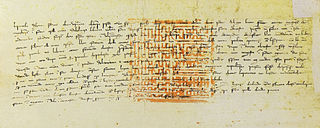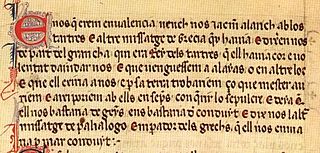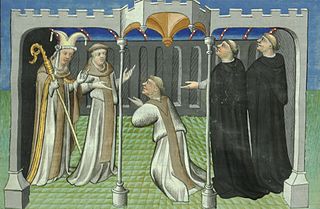Related Research Articles

Year 1287 (MCCLXXXVII) was a common year starting on Wednesday of the Julian calendar.

Abaqa Khan, was the second Mongol ruler (Ilkhan) of the Ilkhanate. The son of Hulagu Khan and Lady Yesünčin and the grandson of Tolui, he reigned from 1265 to 1282 and was succeeded by his brother Ahmed Tekuder. Much of Abaqa's reign was consumed with civil wars in the Mongol Empire, such as those between the Ilkhanate and the northern khanate of the Golden Horde, and the Chagatai Khanate in Central Asia. Abaqa also engaged in unsuccessful attempts at invading Syria under the Mamluk Sultanate, which included the Second Battle of Homs.

Rabban Bar Ṣawma, also known as Rabban Ṣawma or Rabban Çauma, was a Uyghur or Ongud monk turned diplomat of the "Nestorian" Church of the East in China. He is known for embarking on a pilgrimage from Yuan China to Jerusalem with one of his students, Markos. Due to military unrest along the way, they never reached their destination, but instead spent many years in Ilkhanate-controlled Baghdad.

Arghun Khan was the fourth ruler of the Mongol empire's Ilkhanate division, from 1284 to 1291. He was the son of Abaqa Khan, and like his father, was a devout Buddhist. He was known for sending several emissaries to Europe in an unsuccessful attempt to form a Franco-Mongol alliance against the Muslim Mamluks in the Holy Land. It was also Arghun who requested a new bride from his great-uncle Kublai Khan. The mission to escort the young Kököchin across Asia to Arghun was reportedly entrusted to Marco Polo. Arghun died before Kököchin arrived, so Arghun's son Ghazan married her instead.
Kitbuqa Noyan, also spelled Kitbogha, Kitboga, or Ketbugha, was an Eastern Christian of the Naimans, a group that was subservient to the Mongol Empire. He was a lieutenant and confidant of the Mongol Ilkhan Hulagu, assisting him in his conquests in the Middle East including the sack of Baghdad in 1258. When Hulagu took the bulk of his forces back with him to attend a ceremony in Mongolia, Kitbuqa was left in control of Syria, and was responsible for further Mongol raids southwards towards the Mamluk Sultanate based in Cairo. He was killed in 1260 at the Battle of Ain Jalut, which was the first major loss of the Mongolian advances and halted their expansion into Arabia and Europe.

René Grousset was a French historian who was curator of both the Cernuschi Museum and the Guimet Museum in Paris and a member of the prestigious Académie française. He wrote several major works on Asiatic and Oriental civilizations, with his two most important works being Histoire des croisades et du royaume franc de Jérusalem (1934–1936) and The Empire of the Steppes: A History of Central Asia (1939), both of which were considered standard references on the subject.

John of Montecorvino, OFM was an Italian Franciscan missionary, traveller and statesman, founder of the earliest Latin Catholic missions in India and China, and Archbishop of Peking. He converted many people during his missionary work and established several churches in Yuan dynasty-held Beijing. John wrote a letter intending to convert the Great Khan to Catholicism. He was a contemporary of Marco Polo.

Ascelin of Lombardy, also known as Nicolas Ascelin or Ascelin of Cremona, was a 13th-century Dominican friar whom Pope Innocent IV sent as an envoy to the Mongols in March 1245. Ascelin met with the Mongol ruler Baiju, and then returned to Europe with a message and Mongol envoys in 1248.

Hayton of Corycus, O.Praem was a medieval Armenian nobleman and historiographer. He was also a member of Norbertines and likely a Catholic priest.

Buscarello de Ghizolfi, also known as Buscarel of Gisolfe, was a European who settled in Persia in the 13th century while it was part of the Mongol Ilkhanate. He was a Mongol ambassador to Europe from 1289 to 1305, serving the Mongol rulers Arghun, Ghazan and then Oljeitu. The goal of the communications was to form a Franco-Mongol alliance between the Mongols and the Europeans against the Muslims, but despite many back-and-forth communications, the attempts were never successful.
David of Ashby was an English-born Dominican friar who was sent from the Holy Land city of Acre to the Mongol ruler Hulagu in 1260, by the Papal legate Tommaso Agni. He stayed around 15 years among the Mongols, and only returned from Iran in 1274.

In modern times the Mongols are primarily Tibetan Buddhists, but in previous eras, especially during the time of the Mongol empire, they were primarily shamanist, and had a substantial minority of Christians, many of whom were in positions of considerable power. Overall, Mongols were highly tolerant of most religions, and typically sponsored several at the same time. Many Mongols had been proselytized by the Church of the East since about the seventh century, and some tribes' primary religion was Christian. In the time of Genghis Khan, his sons took Christian wives of the Keraites, and under the rule of Genghis Khan's grandson, Möngke Khan, the primary religious influence was Christian.

Jayme Alaric de Perpignan was an ambassador sent by Pope Clement IV and James I of Aragon to the Mongol ruler Abaqa Khan in 1267.

Sempad the Constable was a noble Cilician Armenia. He was an older brother of King Hetoum I. He was an important figure in Cilicia, acting as a diplomat, judge, and military officer, holding the title of Constable or Sparapet, supreme commander of the Armenian armed forces. He was also a writer and translator, especially known for providing translations of various legal codes, and the creation of an important account of Cilician history, called in French the Chronique du Royaume de Petite Armenie. He fought in multiple battles, such as the Battle of Mari, and was trusted by his brother King Hetoum to be a key negotiator with the Mongol Empire.
Mar Denha I was Patriarch of the Church of the East from 1265 to 1281. He was widely suspected of murdering Shem'on Bar Qaligh, bishop of Tus, and was remembered by later generations as Denha Qatola, 'Denha the Murderer'.

Samagar, also Cemakar, was a Mongol general of the Il-Khan ruler Abaqa Khan (1234–1282), mentioned as leading a Mongol invasion force in 1271, in attempted coordination with the Ninth Crusade.
Aïbeg and Serkis, also Aibeg and Sergis or Aïbäg and Särgis, were two ambassadors sent by the Mongol ruler Baichu to Pope Innocent IV in 1247–1248. They were the first Mongol envoys to Europe.

Yahballaha III, known in earlier years as Rabban Marcos was Patriarch of the East from 1281 to 1317. As patriarch, Yahballaha headed the Church of the East during the severe persecutions under the reign of khans Ghazan and his successor Öljaitü. He acknowledged the primacy of the Pope and tried to form a church union, which was rejected by the traditionalist bishops of the Church of the East.

Mongol Armenia or Ilkhanid Armenia refers to the period beginning in the early-to-mid 13th century during which both Zakarid Armenia and the Armenian Kingdom of Cilicia became tributary and vassal to the Mongol Empire and the successor Ilkhanate. Armenia and Cilicia remained under Mongol influence until around 1335.

The fall of Outremer describes the history of the Kingdom of Jerusalem from the end of the last European Crusade to the Holy Land in 1272 until the final loss in 1302. The kingdom was the center of Outremer—the four Crusader states—which formed after the First Crusade in 1099 and reached its peak in 1187. The loss of Jerusalem in that year began the century-long decline. The years 1272–1302 were fraught with many conflicts throughout the Levant as well as the Mediterranean and Western European regions, and many Crusades were proposed to free the Holy Land from Mamluk control. The major players fighting the Muslims included the kings of England and France, the kingdoms of Cyprus and Sicily, the three Military Orders and Mongol Ilkhanate. Traditionally, the end of Western European presence in the Holy Land is identified as their defeat at the Siege of Acre in 1291, but the Christian forces managed to hold on to the small island fortress of Ruad until 1302.
References
- "Histoires des Croisades III", Rene Grousset